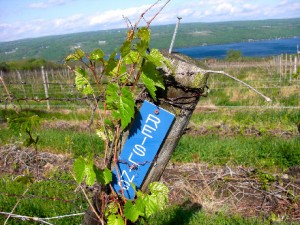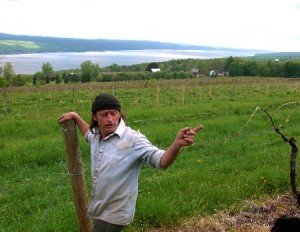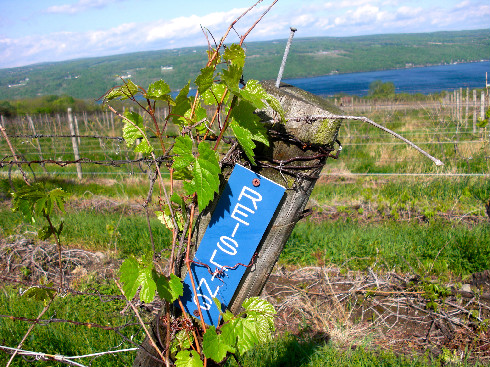By Rick VanSickle
FINGER LAKES, N.Y. — There is absolutely no question that Riesling is one of Niagara’s signature grapes. It grows so well here every vintage, it’s affordable and catching on with consumers, winemakers understand it, and the resulting wines are world class in quality.
But are wineries doing everything they can to help consumers better come to terms with Riesling?

It’s a question that not only confronts Niagara wineries but also any region that is trying to establish an identity for a certain style of wine.
That was evident recently during a trip to the Finger Lakes wine region in New York, a mere three-hour drive from St. Catharines, where Riesling has emerged as a major force in that cool climate growing area.
The quality Rieslings are built on a firm backbone of acidity, minerality and mouth-puckering citrus fruits. The top wines are generally bone dry, austere, mineral laden and made for drinking with food or aging in the cellar where they have time to shed some of those sharp edges.
That’s not to say there aren’t Rieslings that climb the sweetness scale. There are. And most wineries produce a variety of styles from dry to semi-sweet and all the way up to the ultra rich and exotic icewines that are similar in style to Niagara’s signature export.
What New York state wines lack is a concerted effort to control quality in the wine regions. There is no equivalent to the Vintners Quality Alliance (VQA), an “appellation of origin†system that guarantees authenticity of origin and stipulates minimum quality standards for Canadian wines.
But many N.Y. wineries are working toward some system that divides the serious wineries from those delving in practices that would raise eyebrows in other regions, including Niagara.
Where the Finger Lakes is clearly ahead of Niagara is in identifying what consumers are buying when purchasing Riesling wines. The majority of wineries have some sort of identification on the label that tells the consumer whether it’s dry, semi-dry, semi-sweet or sweet. There is no mystery, for the most part.

In Niagara, it’s a crapshoot. Only a handful of wineries declare the sweetness (or lack of) clearly on the label to help the consumer make a sound decision. There is nothing worse than buying a bottle of wine that you think is bone dry and finding out it’s sweet. It’s a disservice to the consumer who will more than likely just not be back to try your wines again.
In the Finger Lakes, a lot of wineries are jumping on the Washington State-based International Riesling Foundation Taste Scale bandwagon, a system of rating the sweetness of wines in simple terms with a graphic on the back label. The scale takes into account residual sugar and acidity so that the rating is really “perceived†sweetness and not based on absolute sugar levels, which can be deceiving.
It’s not a perfect system but one that is being used in the major Riesling markets of the world. So why hasn’t it caught on in Niagara?
I asked Brian Schmidt, winemaker of Vineland Estates Winery, and a major Riesling producer in Niagara, for his thoughts on the International Riesling Foundation Taste Scale. He said he loves it and will be joining the foundation now that VQA (Schmidt is vice-chairman of VQA’s board of directors), has gone to the government of Ontario to ask that it get out of the business of regulating sweetness descriptors on white wine labels. The VQA had imposed restrictive rules on its members that made it difficult to describe levels of sweetness.
If the government signs off on the proposal, Niagara wineries will be free to describe the sweetness of their wines any way they want to.
“VQA voted to remove themselves from the sweetness descriptor business,†Schmidt said. The move opens the door to put “whatever you want on the label.â€
Schmidt, who makes several different Rieslings at Vineland Estate, is immediately joining the International Riesling Foundation and will have the new taste scale on his labels as quickly as he can, provided the government changes legislation.
He’s not alone. Cave Spring Wine Cellars is already a member (Leonard Pennachetti, president of Cave Spring is on the Board of Directors has been a member from the beginning and uses the taste scale at their retail store) and others, such as Fielding Estate, which was ready to put the scale on its 2009 Rieslings but was rejected pending changes before the government, will also join as soon as they can.
Anything that “reduces consumer confusion†is something Fielding Estate in favour of, winemaker Richie Roberts said.
We can only hope that other Niagara producers follow suit and adopt the taste scale for all bottles of Riesling here. It’s called progress. And we can all drink to that.
Here’s a Finger Lakes Riesling available at Vintages to try in comparison with a Niagara Riesling:
Hermann J. Wiemer Dry Riesling 2006 ($30, Vintages, 4 stars) Hermann J. Wiemer has one of the most extensive portfolios of Rieslings in the Finger Lakes and treats this grape with a great deal of respect. Most of the wines are done in a bone-dry style with searing acidity that softens over time. Look for quince, citrus-lime, minerals and a slight note of petrol emerging.
And a couple from Niagara:
Wayne Gretzky No. 99 Riesling 2008 ($15, winery, web, LCBO, 3.5 stars) A nose of grapefruit, lime and subtle mineral notes in this likeable Riesling from the Great One. It starts with zippy citrus fruit in the mouth and adds notes of honey and peach.
Fielding Estate Riesling 2009 ($16, July release, 4 stars) This is a darn fine wine at this price and one to watch for later this summer. Peach, lime, grapefruit on a nose that hints at honey sweetness. It’s fresh and juicy on the palate with a fruit bowl of citrus fruit, a mineral edge and balancing acidity in an off-dry style. Refreshingly delicious wine.
Enjoy!






Comment here